Briones
Briones is a village in the province and autonomous community of La Rioja, Spain. The municipality covers an area of 37.72 square kilometres (14.56 sq mi) and as of 2011 had a population of 873 people.[2]
Briones | |
|---|---|
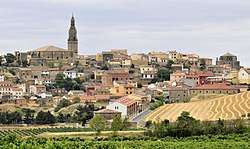 Skyline of Briones | |
 Briones Location of Briones in La Rioja  Briones Briones (Spain) | |
| Coordinates: 42°32′39″N 2°47′06″W | |
| Country | |
| Autonomous community | |
| Comarca | Haro |
| Founded | c. 1st century |
| Government | |
| • Alcalde | María Carmen Ruiz Ruiz (People's Party) |
| Area | |
| • Total | 37.72 km2 (14.56 sq mi) |
| Population (2018)[1] | |
| • Total | 766 |
| • Density | 20/km2 (53/sq mi) |
| Demonym(s) | brionero,ra |
| Time zone | UTC+1 (CET) |
| • Summer (DST) | UTC+2 (CEST) |
| Postal code | 26330 |
| Official language | Spanish |
History
The name Briones comes from the Berones, ancient inhabitants of La Rioja, but, according to a lithic site from the Bronze Age found in the path of the Santos Mártires chapel, Briones had inhabitants before the Beroners. The Albedense Chronicle (c. 883)[3] says that Alfonso I of Asturias cut down the village of Briones and six other municipalities. Besides, the chronicle also mentions the famous expedition led by Alphonso I, king of Asturias all the way down the Ebro river in 740. In that chronicle, these destroyed villages are mentioned: Mirandam (now Miranda de Ebro), Revedencam, Carbonariam, Abeicam (Ábalos, where the expedition crossed the Ebro river), Brunes (this might be Briones but it is uncertain), Cinissariam (now Cenicero) and Alesanco.
Briones was under Saracen control until the late 9th century, and it belonged to King Ordoño II of León since the beginnings of the 10th century. Briones also belonged to the Castilla County, which had been repopulated with Basques and was a frontier between Castilla and Navarra. After Sancho el de Peñalén was murdered the 4th of June 1076, Alfonso VI took over La Rioja and Briones became part of the domain of Haro. Fernando III named Don Diego López III de Haro, the monarch's nephew, first Lord of Briones. In 1240 Don Diego López rebelled against Fernando III and found shelter in Briones. The king enclosed the town and made him prisoner. Since then, Briones belonged to the crown. On the 18 January 1256, Alfonso X of Castile gave Briones the regional laws from Vitoria, as a guarantee of the Castillian repopulation. In 1293 Sancho IV gave Briones royal privilege. During the Basquisation in 1536 there were thirty Basque surnames in Briones.
Demography
On 1 January 2010 the population of the town was up to 867 inhabitants, 464 men and 403 women.[4]
Interesting places
Iglesia de Nuestra Señora de la Asunción
.jpg)
Built in the 16th century, using the Isabelline Gothic style.
It was declared Bien de Interés Cultural in the monument category on 4 September 1981.[5]
Other buildings
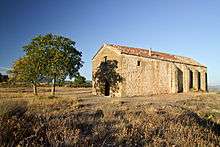

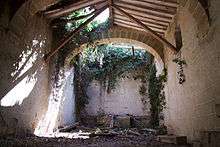
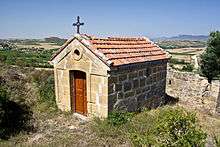
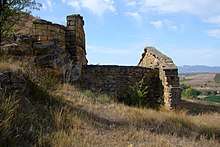
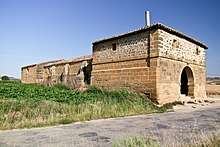
- Ermita del Cristo de los Remedios
- Ermita de los Santos Mártires
- Ermita de Santa Lucía
- Ermita de San Andrés
- Ermita de San Bartolomé
- Ermita del Calvario
- Ermita de San Bartolomé
- Ermita de la Concepción
- Palacio de Marqués de San Nicolás: From the 17th century. Now the Town Hall
- La casa de los Gadea
Museums
- Vivanco Dinasty Wine Culture Museum
- Ethnographic Museum, aka La casa encantada[6]
Historic-artistic grouping
Briones has been Bien de Interés Cultural in the Conjunto Histórico category since 4 July 1973.[5]
Patronage festivals
- The first Sunday after 14 September, festivity of the Vera Cruz: remembrance of the advocation of the Santo Cristo de los Remedios, patron saint of Briones.
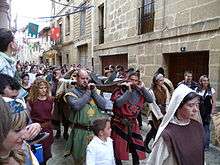
- Jornadas Medievales: third weekend of June. The inhabitants reproduce the life in the village during the 14th century.
Other interesting facts
In 2010 was published in TVE the TV series Gran Reserva. Part of it was filmed in Briones, but in the show it was renamed as Lasiesta.[7]
See also
- List of Bien de Interés Cultural in the Province of La Rioja
- List of municipalities in La Rioja
- La Rioja (Spain)
References
- Municipal Register of Spain 2018. National Statistics Institute.
- "La Rioja: Población por municipios y sexo:Cifras oficiales de población resultantes de la revisión del Padrón municipal a 1 de enero de 2011". Instituto Nacional de Estadística. Retrieved 27 May 2012.
- Germán Bleiberg; Maureen Ihrie; Janet Pérez (1 January 1993). Dictionary of the Literature of the Iberian Peninsula. Greenwood Publishing Group. pp. 462–. ISBN 978-0-313-28731-2.
- INE: Población por municipios y sexo. Archived September 22, 2013, at the Wayback Machine
- Mininsterio de Cultura. Patrimonio Histórico.
- 'La casa encantada' muestra 500 piezas etnográficas originales
- "Briones es Lasiesta de 'Gran Reserva'". Archived from the original on 2014-03-16. Retrieved 2014-03-16.